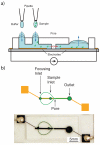A Microfluidic Passive Pumping Coulter Counter
- PMID: 23930109
- PMCID: PMC3735229
- DOI: 10.1007/s10404-010-0609-0
A Microfluidic Passive Pumping Coulter Counter
Abstract
A microfluidic device using on-chip passive pumping was characterized for use as a particle counter. Flow occurred due to a Young-Laplace pressure gradient between two 1.2 mm diameter inlets and a 4 mm diameter reservoir when 0.5μ L fluid droplets were applied to the inlets using a micropipette. Polystyrene particles (10μm diameter) were enumerated using the resistive pulse technique. Particle counts using passive pumping were within 13% of counts from a device using syringe pumping. All pumping methods produced particle counts that were within 16% of those obtained with a hemocytometer. The effect of intermediate wash steps on particle counts within the passive pumping device was determined. Zero, one, or two wash droplets were loaded after the first of two sample droplets. No statistical difference was detected in the mean particle counts among the loading patterns (p > 0.05). Hydrodynamic focusing using passive pumping was also demonstrated.
Keywords: Colloid; Enumeration; Microfluidics; Resistive Pulse.
Figures




Similar articles
-
Investigation of hydrodynamic focusing in a microfluidic coulter counter device.J Biomech Eng. 2012 Aug;134(8):081001. doi: 10.1115/1.4007091. J Biomech Eng. 2012. PMID: 22938354
-
An inertia enhanced passive pumping mechanism for fluid flow in microfluidic devices.Lab Chip. 2012 Jun 21;12(12):2221-8. doi: 10.1039/c2lc20858j. Epub 2012 Mar 23. Lab Chip. 2012. PMID: 22441561
-
A compact microfluidic gradient generator using passive pumping.Microfluid Nanofluidics. 2012 May 1;12(6):887-895. doi: 10.1007/s10404-011-0908-0. Epub 2011 Dec 18. Microfluid Nanofluidics. 2012. PMID: 22737106 Free PMC article.
-
Methods for counting particles in microfluidic applications.Microfluid Nanofluidics. 2009;7(6):739. doi: 10.1007/s10404-009-0493-7. Epub 2009 Aug 20. Microfluid Nanofluidics. 2009. PMID: 32214956 Free PMC article. Review.
-
Passive micropumping in microfluidics for point-of-care testing.Biomicrofluidics. 2020 May 27;14(3):031503. doi: 10.1063/5.0002169. eCollection 2020 May. Biomicrofluidics. 2020. PMID: 32509049 Free PMC article. Review.
Cited by
-
Advances in passively driven microfluidics and lab-on-chip devices: a comprehensive literature review and patent analysis.RSC Adv. 2020 Mar 23;10(20):11652-11680. doi: 10.1039/d0ra00263a. eCollection 2020 Mar 19. RSC Adv. 2020. PMID: 35496619 Free PMC article. Review.
-
Label-free counting of affinity-enriched circulating tumor cells (CTCs) using a thermoplastic micro-Coulter counter (μCC).Analyst. 2020 Mar 2;145(5):1677-1686. doi: 10.1039/c9an01802f. Analyst. 2020. PMID: 31867587 Free PMC article.
-
Microfluidics for cryopreservation.Biotechnol Adv. 2017 Mar-Apr;35(2):323-336. doi: 10.1016/j.biotechadv.2017.01.006. Epub 2017 Jan 30. Biotechnol Adv. 2017. PMID: 28153517 Free PMC article. Review.
-
Spontaneous electrical charging of droplets by conventional pipetting.Sci Rep. 2013;3:2037. doi: 10.1038/srep02037. Sci Rep. 2013. PMID: 23784001 Free PMC article.
References
-
- Arndt S, Seebach J, Psathaki K, Galla H, Wegener J. Bioelectrical impedance assay to monitor changes in cell shape during apoptosis. Biosens Bioelectron. 2004;19(6):583–594. - PubMed
-
- Ateya D, Sachs F, Gottlieb P, Besch S, Hua S. Volume cytometry: Microfluidic sensor for high-throughput screening in real time. Analytical Chemistry. 2005;77(5):1290–1294. - PubMed
-
- Benazzi G, Holmes D, Sun T, Mowlem MC, Morgan H. Discrimination and analysis of phytoplankton using a microfluidic cytometer. IET Nanobiotechnol. 2007;1(6):94–101. - PubMed
-
- Berthier E, Beebe DJ. Flow rate analysis of a surface tension driven passive micropump. Lab Chip. 2007;7(11):1475–1478. - PubMed
Grants and funding
LinkOut - more resources
Full Text Sources
